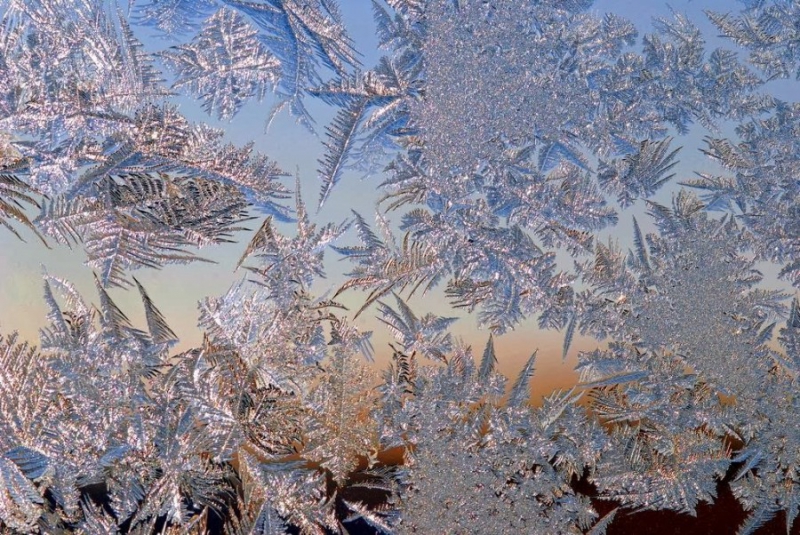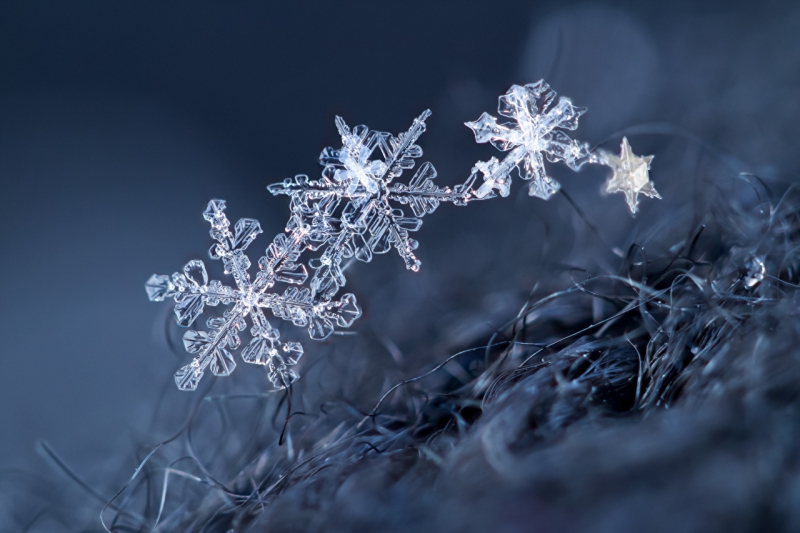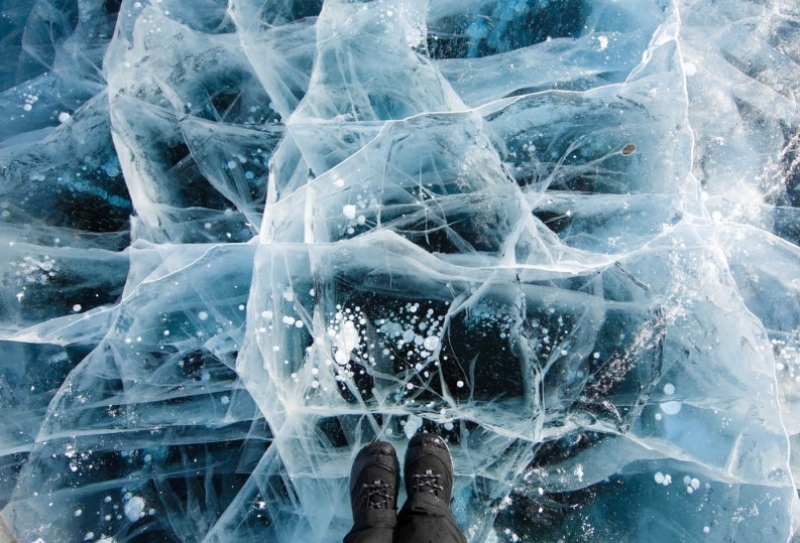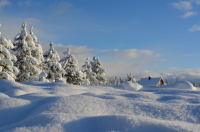Why do seasons have to change in the first place?
Roughly speaking, it’s all because of the tilt in our planet’s axis of rotation, so that during one half of the year, one hemisphere gets more of the Sun’s attention, and the other half is vice versa. The very fact of this axial tilt’s existence causes the change in seasons. If the Earth’s axis was perpendicular to the Earth’s orbital plane, the Sun would be heating different areas with unvarying intensity, the equator being the biggest receiver of heat. The poles would be the most disadvantaged areas, with the light almost never reaching these parts.
How do frost patterns appear, and why do they never appear on plastic windows?
Based on the way of their formation, frost patterns can be divided into two types: dendrites, or patterns with a branching tree-like structure, and trichites, or patterns with a star-like structure. Tracing the reasons why these emerge is no rocket science. If the air in a room is humid, and the temperature outside has hit a sub-zero mark, the excess humidity condenses itself on a windowpane. As the latter is cold, that vapor has no chance but to cool down and change from a gaseous to solid state, forming wafer-thin crystals as a result.
However perfect it may look, any glass has microscopical defects such as miniature scratches and jags you won’t be able to see with a naked eye. The moisture that settles down on the window’s surface crystallizes on these small defects, and the resulting crystals are then joined by more and more of the new ones, and that’s how frost patterns are formed. Sometimes, it is the dust particles that intersperse the windowpane, or the lines that are left after washing the window, that give rise to this whimsical frostwork. Draughts and air currents are another culprit.

But all of this comes with a caveat. For the frost patterns to be created, both the windowpane and the air that affects it have to be cold enough. Plastic windows have better thermal insulation than their wooden counterparts, which causes the window glass that is on the inside to have a higher temperature. That’s why they’re less frostwork-friendly than wooden windows, which can be considered as more breathable, as they let the cold into houses and apartments more freely, providing perfect conditions for the formation of frost patterns.
The underlying reason is in the difference of how these window types are structured. Old wooden windows typically consist of double frames, each having a single sheet of glass without any insulated glazing. As these frames aren’t airproof, with the space between them filled with humid room air, their cold windowpanes enable the processes of condensation and crystallization. Plastic windows, with their two or three double-glazed panes spaced with a noble gas or dry air free from dust and moisture, have nothing to add to the condensation process: there’s no moisture in the vetrocamera, and the inside windowpane is too warm for the frostwork to appear.
Another reason is in how clean these windows are. Old wooden windows are often dirtier and dustier than plastic ones, and as we’ve already established, dust plays a key role in the formation of frostwork. On the other hand, if you wake up and there are frost patterns on your plastic window, you can take it a sign that the latter wasn’t fitted in a correct way, as something is wrong with its insulation.
Why are snowflakes shaped differently?
Hate to break it to you, but science obliges: there’s no magic in snowflakes. Rather, they’re a result of a complex natural process that begins by water being attracted to tiny solid particles in the air. Therefore, snowflakes appear in the air that is, in essence, not ideally clean.

Laying the foundation for our future snowflake is a hexagonal prism that forms around the microparticle. It then continues to grow in its size, its final shape depending on the conditions this process takes place in. These are in turn defined by five different factors: atmospheric pressure, a cloud’s electrical field, wind, humidity and temperature, which is the most important here as it is this that determines whether the top and bottom prisms, or their side planes, will develop or change their shape or not. In the course of its formation, a snowflake grows from half a millimeter to a couple of millimeters in size.
The temperatures of −5 to −10°C create snowflakes that look like little needles or minuscule columns. Those of −10 to −12°C give rise to snowflakes in the form of small plates or, indeed, flakes. The most complex, star-like snowflakes form under the temperatures of −12 to −18°C, so it’s when the cruelest frosts strike that we see the most beautiful flecks of snow, each like a little piece of art in itself.
That said, even from our early years we know that each snowflake is unique. Oft-repeated in children’s songs, this statement has a full scientific backing, as snowflakes are formed from water crystals that are all different both in shape and number.
Why is ice slippery, snow white, and frozen water clear?
The color of snow and frozen water is bound to their structure. Ice crystals are organized in strict order and have a clear orientation. This is why passing through the ice doesn’t impact the light’s direction that much. Shambolic in structure, snow crystals are on the polar side of the spectrum. Falling onto one snow crystal, the light bounces off to another one, which then once again changes its direction. Snowflakes are capable of decomposing the white light into its colored spectral components, but all of this results in the color white in the end.

If you press against ice, it will start to melt in the place of the indentation. When we step on the ice, we press on its surface, and this creates a thin layer of water under our feet. The overall friction decreases, and we slip, in the same as we often do when the floor is wet.
Even when the frost bites the most, the ice isn’t fully solid. Its surface is always covered with a layer of half-frozen water, in which molecules fluctuate at a 90° angle to the surface of the ice, whilst also staying in their respective places (that’s the reason why this layer is half solid, half liquid). The colder is the ice, the thinner is this layer, the thinnest being one-atom width. This layer acts as an additional lubricant film which causes us to slip.
Why do my glasses fog up when I enter a building?
The amount of moisture present in the air depends on the latter’s temperature: the higher it is, the more moisture the air can hold. When a glass-wearer steps inside from the cold, their glasses cool the two or three millimeters of the air around them, causing this air to lose its capacity for holding all the moisture it had before. This moisture then gathers on the closest surface available, i.e. the glasses themselves. The higher the room’s humidity, the more fogged-up your glasses will become.
Why does the phone switch off when it’s cold outside?
Don’t blame the phone, blame the phone battery. Modern lithium-ion batteries have a higher self-discharge current: because the gel-like electrolyte is where the ion exchange process takes place, its cooling down leads to a sharp decrease in the ion exchange. The battery’s voltage drops, and the phone switches off. Once the battery is warmed up again, the electrolyte activates the ion exchange, and the charge is restored.

iPhone holders experience the biggest difficulties with their phones conking out right in the middle of a nice walk on a wintry day. There are several reasons for this, first being the materials the phone’s casing is made of. Aluminum, which is the main component of the later-generation iPhones’ casing, has a high thermal conductivity, and so freezes off very quickly. Even though glass, which makes up the screen, doesn’t have that much of a high thermal conductivity, this is enough for the phone (and, subsequently, its owner) to suffer under low temperatures. Plastic is a different case; having a lesser thermal conductivity than that of metals and glass, it can endure extremely cold temperatures, even those up to −35°C.
The second reason why iPhones are a bit of a wimp when it comes to sub-zero weather is that they have a casing that is not thick enough. Slim phones are great, but they’re also more likely to malfunction than thick, brick-like ones. You win some, you lose some, eh?





